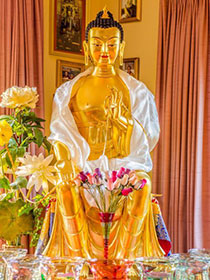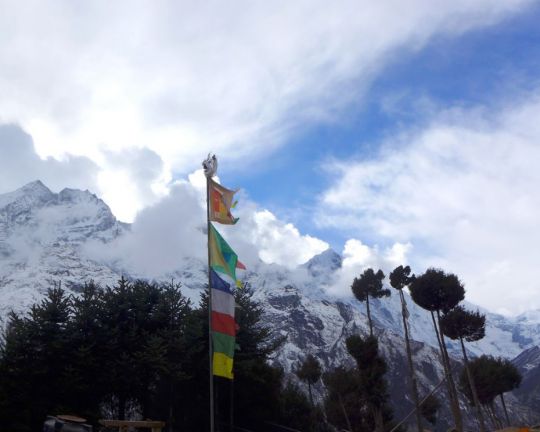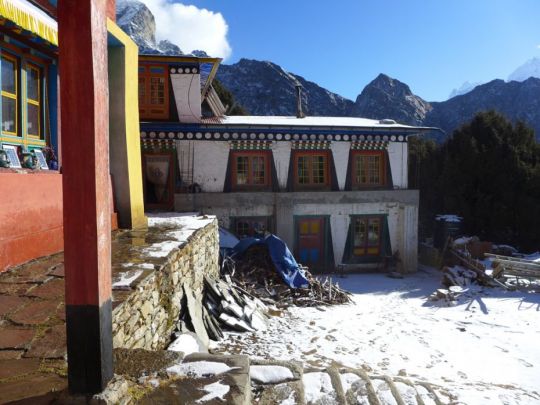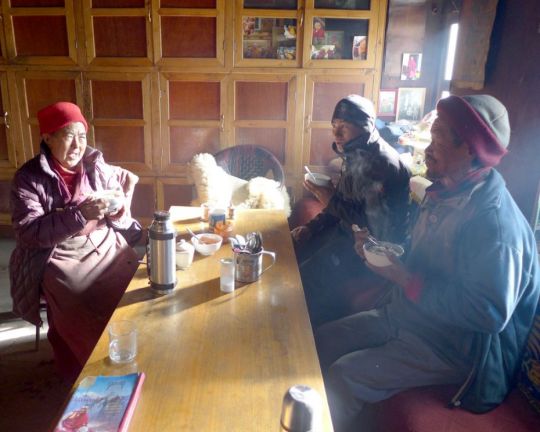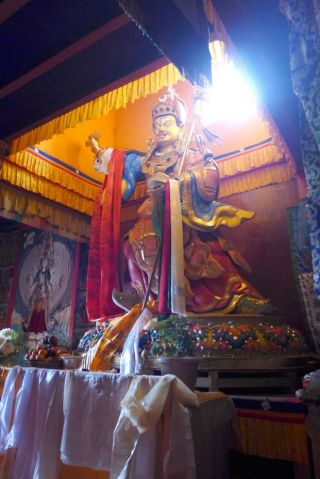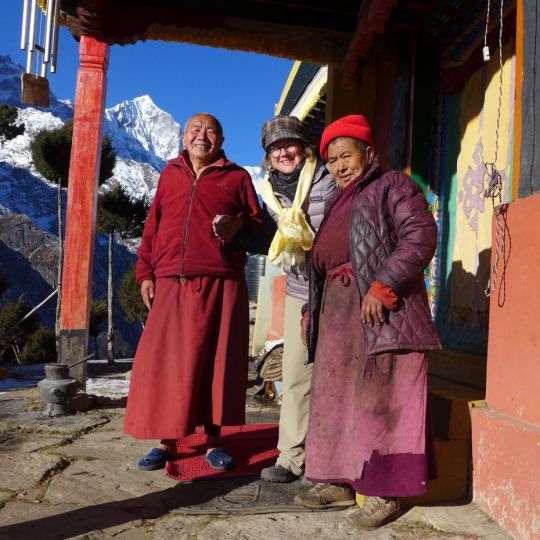- Home
- FPMT Homepage
Foundation for the Preservation of the Mahayana Tradition
The FPMT is an organization devoted to preserving and spreading Mahayana Buddhism worldwide by creating opportunities to listen, reflect, meditate, practice and actualize the unmistaken teachings of the Buddha and based on that experience spreading the Dharma to sentient beings. We provide integrated education through which people’s minds and hearts can be transformed into their highest potential for the benefit of others, inspired by an attitude of universal responsibility and service. We are committed to creating harmonious environments and helping all beings develop their full potential of infinite wisdom and compassion. Our organization is based on the Buddhist tradition of Lama Tsongkhapa of Tibet as taught to us by our founders Lama Thubten Yeshe and Lama Thubten Zopa Rinpoche.
- Willkommen
Die Stiftung zur Erhaltung der Mahayana Tradition (FPMT) ist eine Organisation, die sich weltweit für die Erhaltung und Verbreitung des Mahayana-Buddhismus einsetzt, indem sie Möglichkeiten schafft, den makellosen Lehren des Buddha zuzuhören, über sie zur reflektieren und zu meditieren und auf der Grundlage dieser Erfahrung das Dharma unter den Lebewesen zu verbreiten.
Wir bieten integrierte Schulungswege an, durch denen der Geist und das Herz der Menschen in ihr höchstes Potential verwandelt werden zum Wohl der anderen – inspiriert durch eine Haltung der universellen Verantwortung und dem Wunsch zu dienen. Wir haben uns verpflichtet, harmonische Umgebungen zu schaffen und allen Wesen zu helfen, ihr volles Potenzial unendlicher Weisheit und grenzenlosen Mitgefühls zu verwirklichen.
Unsere Organisation basiert auf der buddhistischen Tradition von Lama Tsongkhapa von Tibet, so wie sie uns von unseren Gründern Lama Thubten Yeshe und Lama Thubten Zopa Rinpoche gelehrt wird.
- Bienvenidos
La Fundación para la preservación de la tradición Mahayana (FPMT) es una organización que se dedica a preservar y difundir el budismo Mahayana en todo el mundo, creando oportunidades para escuchar, reflexionar, meditar, practicar y actualizar las enseñanzas inconfundibles de Buda y en base a esa experiencia difundir el Dharma a los seres.
Proporcionamos una educación integrada a través de la cual las mentes y los corazones de las personas se pueden transformar en su mayor potencial para el beneficio de los demás, inspirados por una actitud de responsabilidad y servicio universales. Estamos comprometidos a crear ambientes armoniosos y ayudar a todos los seres a desarrollar todo su potencial de infinita sabiduría y compasión.
Nuestra organización se basa en la tradición budista de Lama Tsongkhapa del Tíbet como nos lo enseñaron nuestros fundadores Lama Thubten Yeshe y Lama Zopa Rinpoche.
A continuación puede ver una lista de los centros y sus páginas web en su lengua preferida.
- Bienvenue
L’organisation de la FPMT a pour vocation la préservation et la diffusion du bouddhisme du mahayana dans le monde entier. Elle offre l’opportunité d’écouter, de réfléchir, de méditer, de pratiquer et de réaliser les enseignements excellents du Bouddha, pour ensuite transmettre le Dharma à tous les êtres. Nous proposons une formation intégrée grâce à laquelle le cœur et l’esprit de chacun peuvent accomplir leur potentiel le plus élevé pour le bien d’autrui, inspirés par le sens du service et une responsabilité universelle. Nous nous engageons à créer un environnement harmonieux et à aider tous les êtres à épanouir leur potentiel illimité de compassion et de sagesse. Notre organisation s’appuie sur la tradition guéloukpa de Lama Tsongkhapa du Tibet, telle qu’elle a été enseignée par nos fondateurs Lama Thoubtèn Yéshé et Lama Zopa Rinpoché.
Visitez le site de notre Editions Mahayana pour les traductions, conseils et nouvelles du Bureau international en français.
Voici une liste de centres et de leurs sites dans votre langue préférée
- Benvenuto
L’FPMT è un organizzazione il cui scopo è preservare e diffondere il Buddhismo Mahayana nel mondo, creando occasioni di ascolto, riflessione, meditazione e pratica dei perfetti insegnamenti del Buddha, al fine di attualizzare e diffondere il Dharma fra tutti gli esseri senzienti.
Offriamo un’educazione integrata, che può trasformare la mente e i cuori delle persone nel loro massimo potenziale, per il beneficio di tutti gli esseri, ispirati da un’attitudine di responsabilità universale e di servizio.
Il nostro obiettivo è quello di creare contesti armoniosi e aiutare tutti gli esseri a sviluppare in modo completo le proprie potenzialità di infinita saggezza e compassione.
La nostra organizzazione si basa sulla tradizione buddhista di Lama Tsongkhapa del Tibet, così come ci è stata insegnata dai nostri fondatori Lama Thubten Yeshe e Lama Zopa Rinpoche.
Di seguito potete trovare un elenco dei centri e dei loro siti nella lingua da voi prescelta.
- 欢迎 / 歡迎
简体中文
“护持大乘法脉基金会”( 英文简称:FPMT。全名:Foundation for the Preservation of the Mahayana Tradition) 是一个致力于护持和弘扬大乘佛法的国际佛教组织。我们提供听闻,思维,禅修,修行和实证佛陀无误教法的机会,以便让一切众生都能够享受佛法的指引和滋润。
我们全力创造和谐融洽的环境, 为人们提供解行并重的完整佛法教育,以便启发内在的环宇悲心及责任心,并开发内心所蕴藏的巨大潜能 — 无限的智慧与悲心 — 以便利益和服务一切有情。
FPMT的创办人是图腾耶喜喇嘛和喇嘛梭巴仁波切。我们所修习的是由两位上师所教导的,西藏喀巴大师的佛法传承。
繁體中文
護持大乘法脈基金會”( 英文簡稱:FPMT。全名:Found
ation for the Preservation of the Mahayana Tradition ) 是一個致力於護持和弘揚大乘佛法的國際佛教組織。我們提供聽聞, 思維,禪修,修行和實證佛陀無誤教法的機會,以便讓一切眾生都能 夠享受佛法的指引和滋潤。 我們全力創造和諧融洽的環境,
為人們提供解行並重的完整佛法教育,以便啟發內在的環宇悲心及責 任心,並開發內心所蘊藏的巨大潛能 — 無限的智慧與悲心 – – 以便利益和服務一切有情。 FPMT的創辦人是圖騰耶喜喇嘛和喇嘛梭巴仁波切。
我們所修習的是由兩位上師所教導的,西藏喀巴大師的佛法傳承。 察看道场信息:
- FPMT Homepage
- News/Media
-
- Study & Practice
-
-
- About FPMT Education Services
- Latest News
- Programs
- New to Buddhism?
- Buddhist Mind Science: Activating Your Potential
- Heart Advice for Death and Dying
- Discovering Buddhism
- Living in the Path
- Exploring Buddhism
- FPMT Basic Program
- FPMT Masters Program
- FPMT In-Depth Meditation Training
- Maitripa College
- Lotsawa Rinchen Zangpo Translator Program
- Universal Education for Compassion & Wisdom
- Online Learning Center
-
- Prayers & Practice Materials
- Overview of Prayers & Practices
- Full Catalogue of Prayers & Practice Materials
- Explore Popular Topics
- Benefiting Animals
- Chenrezig Resources
- Death & Dying Resources
- Lama Chopa (Guru Puja)
- Lama Zopa Rinpoche: Compendium of Precious Instructions
- Lama Zopa Rinpoche: Life Practice Advice
- Lama Zopa Rinpoche Practice Series
- Lamrim Resources
- Mantras
- Prayer Book Updates
- Purification Practices
- Sutras
- Thought Transformation (Lojong)
- Audio Materials
- Dharma Dates - Tibetan Calendar
- Translation Services
- Publishing Services
- Ways to Offer Support
- Prayers & Practice Materials
-
- Teachings and Advice
- Find Teachings and Advice
- Lama Zopa Rinpoche Advice Page
- Lama Zopa Rinpoche: Compendium of Precious Instructions
- Lama Zopa Rinpoche Video Teachings
- ༧སྐྱབས་རྗེ་བཟོད་པ་རིན་པོ་ཆེ་མཆོག་ནས་སྩལ་བའི་བཀའ་སློབ་བརྙན་འཕྲིན།
- Podcasts
- Lama Yeshe Wisdom Archive
- Buddhism FAQ
- Dharma for Young People
- Resources on Holy Objects
- Teachings and Advice
-
-
*If a menu item has a submenu clicking once will expand the menu clicking twice will open the page.
-
-
- Centers
-
- Teachers
-
- Projects
-
-
-
-
*If a menu item has a submenu clicking once will expand the menu clicking twice will open the page.
-
-
- FPMT
-
-
-
-
-
I hope that you understand what the word ‘spiritual’ really means. It means to search for – to investigate – the true nature of the mind. There’s nothing spiritual outside. My rosary isn’t spiritual; my robes aren’t spiritual. Spiritual means the mind and spiritual people are those who seek its nature.
Share
Lama Thubten Yeshe
-
-
-
- Shop
-
-
-
The Foundation Store is FPMT’s online shop and features a vast selection of Buddhist study and practice materials written or recommended by our lineage gurus. These items include homestudy programs, prayers and practices in PDF or eBook format, materials for children, and other resources to support practitioners.
Items displayed in the shop are made available for Dharma practice and educational purposes, and never for the purpose of profiting from their sale. Please read FPMT Foundation Store Policy Regarding Dharma Items for more information.
-
-
27
Lawudo Retreat Centre, located in the Solu Khumbu district of Nepal, is where FPMT spiritual director Lama Zopa Rinpoche’s previous incarnation meditated and not far from the village where Rinpoche was born. Mandala editor Laura Miller visited Lawudo in early 2017 and shared this reflection on her experience there.
Visiting Lawudo, high in the Himalayan mountains of Nepal, had been a wish of mine for nearly eight years. And on New Year’s day 2017, my tired legs trudged up the final steep path and carried me into the yard in front of the Lawudo Gompa. Lama Zopa Rinpoche’s sister, Ani Ngawang Samten, stood there as I approached. Tears formed in my eyes when I took her hands, which seemed so soft to me despite five decades of tireless work looking after the holy retreat site. All I could say to her was how happy I was to finally be there. The previous year, my sense of personal accomplishment had sunk to a difficult low. But there I was, standing just under 13,000 feet [4,000 meters], in a place surrounded by gorgeous mountains and graced by highly accomplished practitioners. Just being there, I had achieved something that felt profoundly worthwhile and a little adventurous.
Before starting my trek to Lawudo, I’d read The Lawudo Lama, an invaluable book by Ven. Jamyang Wangmo that tells the story of the inspiring lives of Lawudo Lama Kunzang Yeshe and his reincarnation Lama Zopa Rinpoche, as well as offers a detailed description of the religious and cultural history of the Mount Everest region, where Lawudo is situated. As my Sherpa guide Nursang and I walked over several days up the trail from the airstrip in Lukla to Namche Bazaar to Thame, Lama Zopa Rinpoche’s birthplace, and finally to Lawudo, the mani stones, prayer wheels, stupas, and gompas created endless opportunities for receiving blessings, rejoicing, and contemplating how generations of Sherpas, who populate the area, had made Dharma practice integral to daily life.
I can date the origin of my trip back to the time when I did a little volunteer work for Mandala magazine. While working on something for the former editor, I visited the website for Lawudo Retreat Centre. The thought “I want to go there” shot directly through my mind as I scrolled through photos of the cave where the Lawudo Lama meditated and of the Lawudo Gompa and the mountains and valley that surround them. During the past six years that I’ve worked as the editor of Mandala, I’ve read and re-read stories about Lawudo: the early years when Lama Yeshe and Rinpoche visited; the young boys who became the first Kopan monks; the experiences of Westerner students who traveled there to practice; and Ani Ngawang Samten, who still keeps it all going. When the earthquake devastated Nepal in 2015, I, along with many, many others, anxiously awaited news of what happened in Lawudo.
Fortunately, Lawudo survived and everyone there was OK. When my opportunity came to visit, like so many before me, I spent many happy hours in Ani-la’s smoky kitchen. I intently ate her nourishing food and listened to her first-hand stories of the early days and to her concerns about the always tenuous water supply and what will happen to Lawudo when she can no longer take care of it. That said, Ani-la didn’t seem to care much to talk about the earthquake. The building that contains the kitchen, dining room, and her own room, received significant damage, as did several other buildings, including the gompa and library. She lived in a tent for months while repairs were being made. During my visit, it appeared that most of the major repairs had been done thanks to generous support from the Nepal Earthquake Support Fund.
The story I enjoyed most from Ani-la recounted the fraught, weeks-long effort to bring the very large Guru Rinpoche statue up to Lawudo and into the gompa. There are no roads in the upper Solu Khumbu district. Humans and yaks carry all nature of things in this remote area; helicopters bring in larger goods and shipments. The beautiful Guru Rinpoche statue stands 13.5 feet [14 meters] tall, far too large to be carried very far. In fact, it is so tall that part of the ceiling of the gompa had to be removed in order for it to fit. My retelling of Ani-la’s story wouldn’t do it justice, but her account covered a succession of false starts, involving a very big helicopter, bad weather, drunken pilots, and the statue being stuck inside the helicopter until it wasn’t. The story ended with an auspicious rainbow surrounding the helicopter on its arrival at Mende, just below Lawudo, and the two dozen Sherpas who carried the precious holy object up the steep hill and into the gompa. The Padmasambhava Project for Peace covered the cost of inviting this impressive statue to Lawudo as well as its creation and that of nine other smaller statues of Guru Rinpoche that are now in the Lawudo Gompa.
My visit to Lawudo was short, just a taste. I had one afternoon to meditate in the Lawudo Lama’s cave. But like receiving even a short Dharma teaching from a Buddhist master, that experience had a deep and lasting effect. Thinking about it now, the dollars spent, the hard work of the hike up, the rough accommodations, and the misgivings about the elevation and the state of my body all seem so minuscule when I compare them to simply being able to be in that cave. I hope and dedicate that anyone else who wishes to go to Lawudo be able to do so and that I am able to return. I rejoice and am grateful for all who have supported the Lawudo Retreat Centre over the years and pray that it may continue on for a very long time.
The author thanks Effie Fletcher at Himalayan High Treks and Dharma Journeys Pilgrimages, and Amber Tamang at Three Jewels Adventures for their help with arrangements for the trek.
FPMT.org brings you news of Lama Zopa Rinpoche and of activities, teachings and events from over 160 FPMT centers, projects and services around the globe. If you like what you read, consider becoming a Friend of FPMT, which supports our work.
- Home
- News/Media
- Study & Practice
- About FPMT Education Services
- Latest News
- Programs
- New to Buddhism?
- Buddhist Mind Science: Activating Your Potential
- Heart Advice for Death and Dying
- Discovering Buddhism
- Living in the Path
- Exploring Buddhism
- FPMT Basic Program
- FPMT Masters Program
- FPMT In-Depth Meditation Training
- Maitripa College
- Lotsawa Rinchen Zangpo Translator Program
- Universal Education for Compassion & Wisdom
- Online Learning Center
- Prayers & Practice Materials
- Overview of Prayers & Practices
- Full Catalogue of Prayers & Practice Materials
- Explore Popular Topics
- Benefiting Animals
- Chenrezig Resources
- Death & Dying Resources
- Lama Chopa (Guru Puja)
- Lama Zopa Rinpoche: Compendium of Precious Instructions
- Lama Zopa Rinpoche: Life Practice Advice
- Lama Zopa Rinpoche Practice Series
- Lamrim Resources
- Mantras
- Prayer Book Updates
- Purification Practices
- Sutras
- Thought Transformation (Lojong)
- Audio Materials
- Dharma Dates – Tibetan Calendar
- Translation Services
- Publishing Services
- Teachings and Advice
- Find Teachings and Advice
- Lama Zopa Rinpoche Advice Page
- Lama Zopa Rinpoche: Compendium of Precious Instructions
- Lama Zopa Rinpoche Video Teachings
- ༧སྐྱབས་རྗེ་བཟོད་པ་རིན་པོ་ཆེ་མཆོག་ནས་སྩལ་བའི་བཀའ་སློབ་བརྙན་འཕྲིན།
- Podcasts
- Lama Yeshe Wisdom Archive
- Buddhism FAQ
- Dharma for Young People
- Resources on Holy Objects
- Ways to Offer Support
- Centers
- Affiliates Area
- Teachers
- Projects
- Charitable Projects
- Make a Donation
- Applying for Grants
- News about Projects
- Other Projects within FPMT
- Support International Office
- Projects Photo Galleries
- Give Where Most Needed
- FPMT
- Shop
Subscribe to FPMT News
Translate*
*powered by Google TranslateTranslation of pages on fpmt.org is performed by Google Translate, a third party service which FPMT has no control over. The service provides automated computer translations that are only an approximation of the websites' original content. The translations should not be considered exact and only used as a rough guide.The workshop is in the mind.







